Question
Issue: How to fix KB5022834 fails to install in Windows 10?
Hi, I've been trying to update Windows for some time now, but it does not succeed. I tried to reboot the system but to no avail. KB5022834 is the update that fails every time for me. Any advice?
Solved Answer
Assuming that you haven't altered the default Windows update settings, your operating system will automatically download and install the latest mandatory updates available. Microsoft releases these updates every second Tuesday of the month, commonly known as Patch Tuesday week.
Whenever the update process is initiated, users can expect to receive various types of updates, including security, cumulative, quality, feature, and out-of-band updates. These updates not only enhance security by patching vulnerabilities but also provide greater stability within the operating system, improve existing features, and introduce new ones, as well as make UI tweaks.
KB5022834 was scheduled to release on February 14, 2023, for Windows 10 versions 20H2, 21H2, and 22H2 and included plenty of security improvements and vulnerability patches, as well as improvements to the servicing pack (a component that helps with Windows update installation).
However, some users claimed that KB5022834 does not install for them, hence they can't get the latest Windows improvements. Some people might get an error code at this time, although for others, there's just a message that the installation did not succeed, which makes it difficult to continue the troubleshooting.
Luckily, there are several things you can do to fix KB5022834 installation failures. Since there could be several different reasons for the update errors to arise (for example, corrupted system files, bugged Windows update caches, badly configured services, etc.), there is one one-for-all solution, and you might have to go through several solutions before one works for you.
If you would rather avoid manual steps, you can try using FortectMac Washing Machine X9 automatic PC repair tool, which can quickly and easily find corrupted system files, repair the registry, and deal with post-infection malware damage with ease.
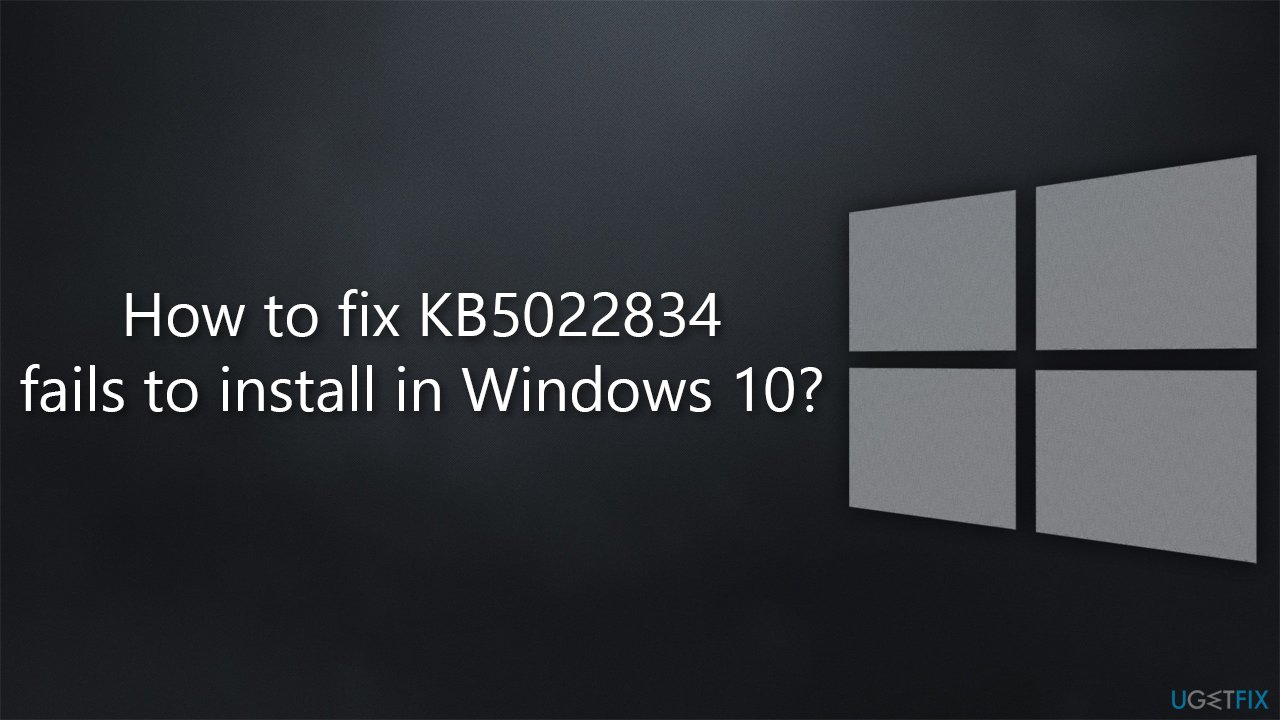
Fix 1. Disable third-party security software
When Windows updates fail, it can be a frustrating experience. Oftentimes, security software can interfere with the update process and cause issues. In such cases, temporarily disabling or uninstalling the security software can be a solution.
This is because security software can sometimes prevent updates from installing properly. The software may see the update as a potential threat and block it, or the update may conflict with the software's settings or configurations. Disabling or uninstalling the security software can allow the update to proceed without interference.
It is important to note that while disabling or uninstalling the security software can help with updating issues, it can leave your system vulnerable to threats. Therefore, it is recommended only to do this temporarily and to re-enable or re-install the software once the updates have been installed successfully.
Fix 2. Check for corrupted system files
- Type cmd in Windows search.
- Right-click on Command Prompt result and select Run as administrator.
- When User Account Control (UAC) shows up, click Yes.
- Use the following command lines, pressing Enter every time:
sfc /scannow
DISM /Online /Cleanup-Image /CheckHealth
DISM /Online /Cleanup-Image /ScanHealth
DISM /Online /Cleanup-Image /RestoreHealth - Restart your PC.
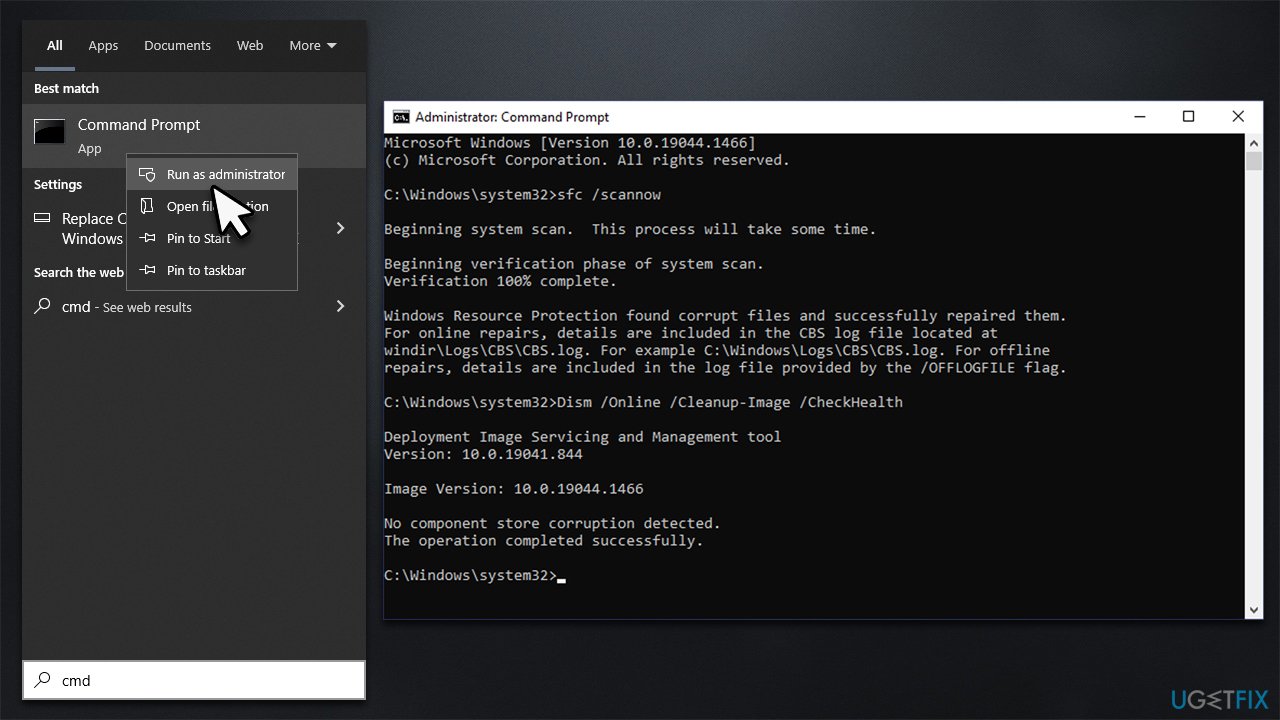
Fix 3. Run troubleshooter
A troubleshooter is a built-in tool that can help you deal with an issue you are having, including Windows updates failing.
- Type Troubleshoot in Windows search.
- Select Additional troubleshooters.
- Find Windows Update from the list.
- Click it and select Run the troubleshooter.
- Apply the suggested fixes and restart your computer.
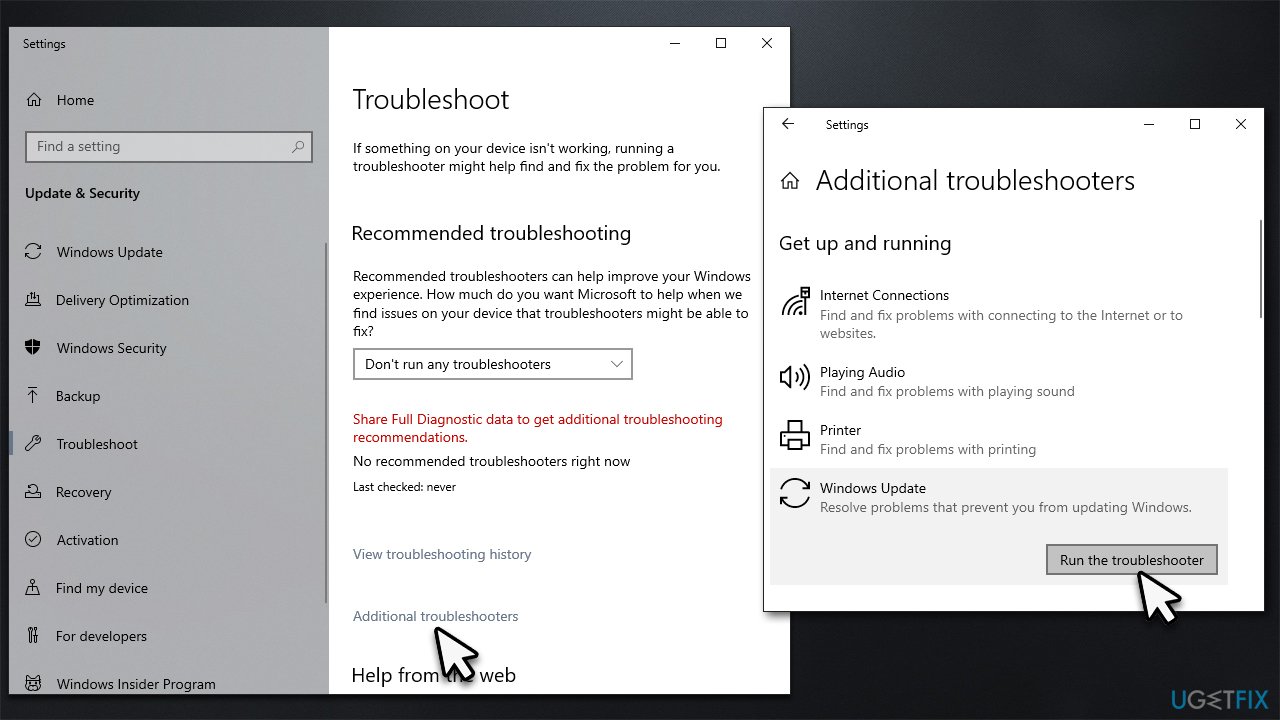
Fix 4. Check BITS and Windows Update services
Certain Windows services must remain enabled in order for Windows updates to be successful – BITS and Windows Update services. If they are running, you should simply restart them. If they are disabled, you should set it to automatic startup type and launch them.
- Type in Services in Windows search and press Enter.
- Locate Background Intelligent Transfer Service (BITS).
- If it is already running, right-click and pick Restart.
- if the service is not running, double-click it, select Automatic under the Startup type from the drop-down menu.
- Click Start, Apply, and OK.
- Do the same with the Windows Update service.
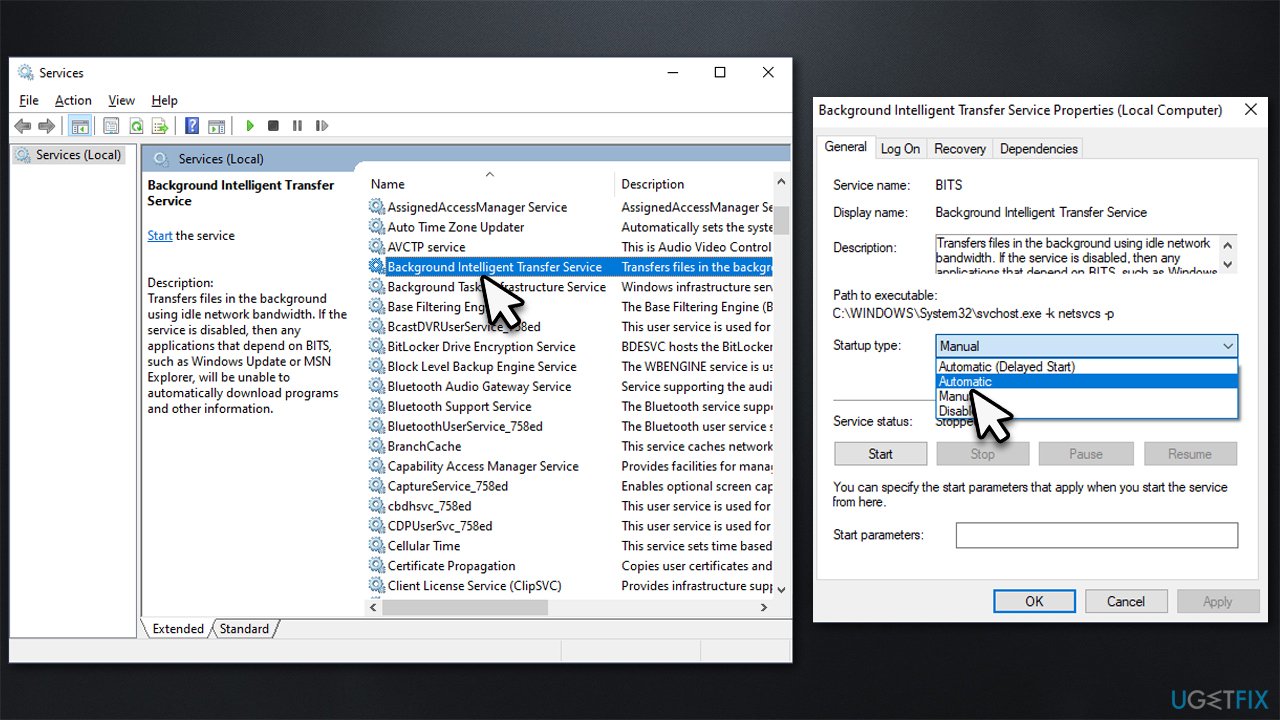
Fix 5. Reset Windows update components
If the previous method did not work, resetting Windows Update components might suffice.
- Open Command Prompt as administrator
- Run the following commands, pressing Enter after each:
net stop bits
net stop wuauserv
net stop appidsvc
net stop cryptsvc
Del “%ALLUSERSPROFILE%\Application Data\Microsoft\Network\Downloader\*.*”
rmdir %systemroot%\SoftwareDistribution /S /Q
rmdir %systemroot%\system32\catroot2 /S /Q
regsvr32.exe /s atl.dll
regsvr32.exe /s urlmon.dll
regsvr32.exe /s mshtml.dll
netsh winsock reset
netsh winsock reset proxy
net start bits
net start wuauserv
net start appidsvc
net start cryptsvc - Restart your computer.
Fix 6. Install KB5022834 manually
- Go to the official Microsoft Update Catalog website.
- Type the KB5022834 into the search bar, and click Search.
- You will find many different versions on the update – you need to find the one that matches your PC specs and Windows version (as a home user, ignore Windows server versions).
- After picking the correct version, click the Download button and proceed with the on-screen instructions.
- Restart your computer to implement the new updates.
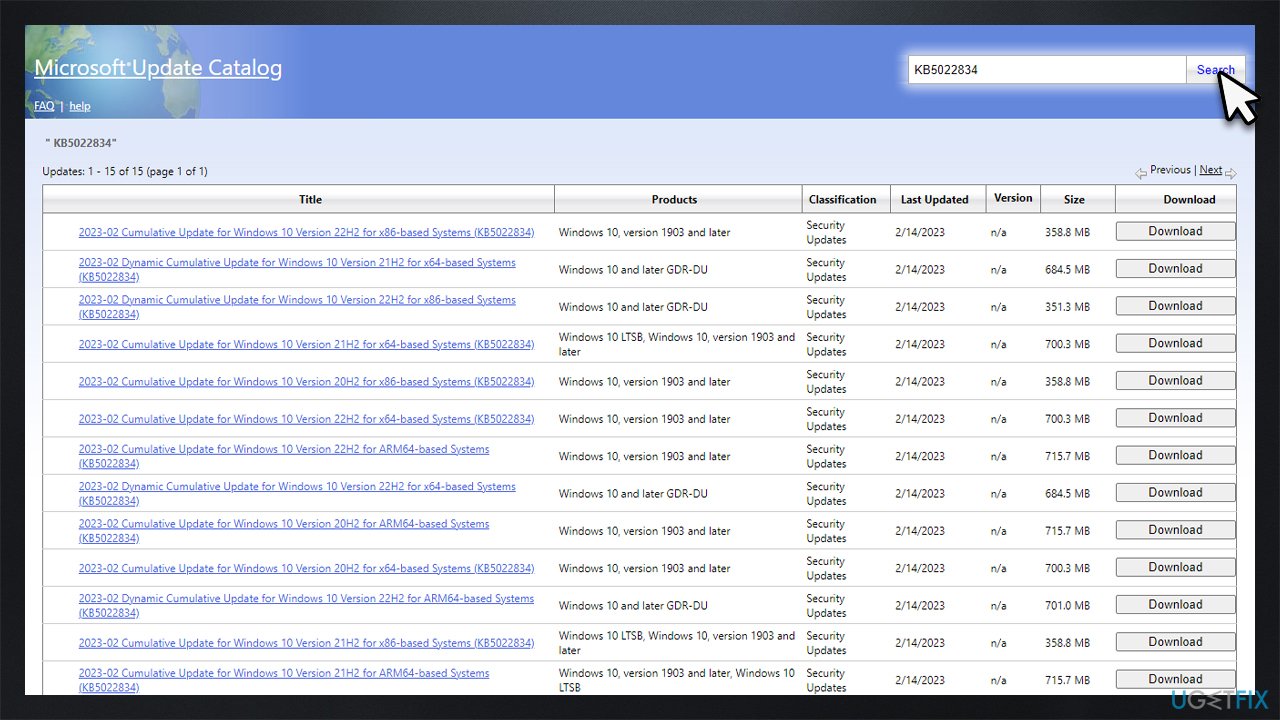
Fix 7. Try the Media Creation Tool
While this solution requires the most effort from users, it often proves the most effective. Before proceeding, make sure you disable or uninstall third-party security software and disconnect external devices, such as printers, leaving just the keyboard and mouse.
- Visit the official Microsoft website and download Windows 10 installation media.
- Double-click the installer and click Yes when the User Account Control window shows up.
- Agree to the terms and click Next.
- Select Upgrade this PC now and click Next.
- Wait for Windows to download files.
- Agree to the terms once again and click Next.
- Before installing, ensure you are happy with your choices (otherwise, you can click the Change what to keep option).
- Click Install to begin the upgrade process.
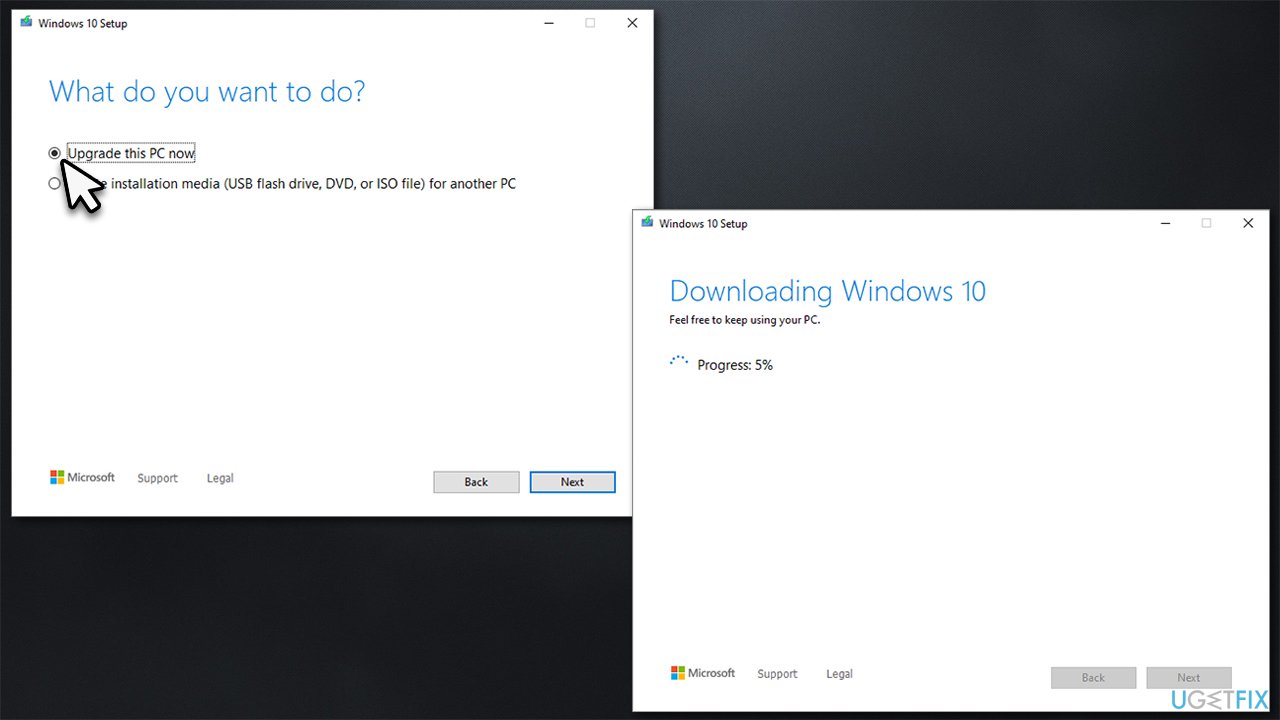
Repair your Errors automatically
ugetfix.com team is trying to do its best to help users find the best solutions for eliminating their errors. If you don't want to struggle with manual repair techniques, please use the automatic software. All recommended products have been tested and approved by our professionals. Tools that you can use to fix your error are listed bellow:
Prevent websites, ISP, and other parties from tracking you
To stay completely anonymous and prevent the ISP and the government from spying on you, you should employ Private Internet Access VPN. It will allow you to connect to the internet while being completely anonymous by encrypting all information, prevent trackers, ads, as well as malicious content. Most importantly, you will stop the illegal surveillance activities that NSA and other governmental institutions are performing behind your back.
Recover your lost files quickly
Unforeseen circumstances can happen at any time while using the computer: it can turn off due to a power cut, a Blue Screen of Death (BSoD) can occur, or random Windows updates can the machine when you went away for a few minutes. As a result, your schoolwork, important documents, and other data might be lost. To recover lost files, you can use Data Recovery Pro – it searches through copies of files that are still available on your hard drive and retrieves them quickly.



